Nhìn kỹ hơn vào xu hướng chăm sóc móng tay bằng nước cốt chanh
We’ve all heard it: when life gives you lemons, use them on your nails. Okay, maybe not quite that phrase, but the idea of a chăm sóc móng tay bằng nước chanh has floated around beauty blogs and Pinterest boards for years. It’s one of those home remedies that promises brighter, stronger, healthier nails with ingredients from your kitchen. Sounds perfect, right?
But not so fast. While the allure of natural nail care is tempting, there’s a flip side to this citrusy trick that not everyone talks about. So, before you start dunking your fingers in lemon juice, let’s take a deeper dive into what this treatment actually does and whether it’s really worth the squeeze.
Phương pháp chăm sóc móng bằng nước cốt chanh là gì?
Touted as a multi-purpose fix for stained, brittle, or fungal-prone nails, the lemon juice nail treatment is exactly what it sounds like: applying fresh lemon juice to your nails and cuticles, either directly, mixed with olive oil, or as a soak.
The appeal lies in the simplicity. Vitamin C? Check. Natural antiseptic? Yup. A kitchen staple that smells great? Absolutely. And, according to DIY devotees, it’s supposed to:
- Loại bỏ vết ố vàng hoặc đổi màu trên móng tay
- Brighten the overall appearance of the nail plate
- Tăng cường móng tay yếu bằng vitamin C
- Fight minor fungal infections thanks to citric acid
It’s easy to see why people give it a try. Plus, compared to pricey nail serums and treatments, it’s incredibly low-cost.
Liệu nó có thực sự hiệu quả không?
Loại. Nước chanh có thể giúp loại bỏ vết bẩn trên bề mặt, như vết bẩn từ sơn móng tay hoặc hút thuốc, nhờ tác dụng tẩy trắng nhẹ của nó. Hãy nghĩ về nó như kem đánh răng làm trắng, nhưng dành cho móng tay của bạn. Sử dụng một cách tiết kiệm, đặc biệt là khi trộn với dầu ô liu, nó thậm chí có thể cung cấp một chút độ ẩm và độ bóng.
There’s also something satisfying about rubbing a slice of lemon across your fingertips. It feels clean, zesty, refreshing. And sure, vitamin C is an essential nutrient that contributes to collagen production, which plays a role in nail strength.
But here’s the kicker. Just because vitamin C is in lemon juice doesn’t mean your nails will soak it up and start growing like wildflowers. The actual amount absorbed through the nail plate is likely minimal, and the benefit is more anecdotal than scientifically proven.
Những nguy cơ tiềm ẩn của việc tự làm móng tay từ cam chanh
This is where things get interesting. While the lemon juice nail treatment might seem harmless, there’s a surprising danger that comes with it, especially if you’re a sun-lover.
Have you ever heard of phytophotodermatitis? It sounds like a spell from Harry Potter, but it’s actually a very real and unpleasant skin reaction. Here’s how it works. Citrus juices like lemon or lime can linger on your skin. If you then go out into the sun, certain compounds in the juice chemically react with UV light, causing redness, streaks, rashes, or even painful blisters.
These reactions can take a day or two to show up, often looking like sunburn, eczema, or even second-degree burns. And get this. They can last for weeks. Not exactly the glowing beauty look you were going for.
Nail professionals and dermatologists warn that even small, raw amounts of lemon juice applied to the skin, especially around the nails and cuticles, can absorb and trigger this effect. So while you’re soaking your nails for beauty, you might be setting yourself up for a seriously uncomfortable experience if you go outdoors too soon after.
Thuốc chữa móng tay tự nhiên bằng chanh có thực sự đáng giá không?
It depends on your goal and your sun exposure. If you’re indoors, trying to gently remove vết bẩn trên móng tay trước khi sơn lớp sơn mới, a one-time lemon juice rub might be fine. Especially if you rinse thoroughly and moisturise afterwards.
But if you’re looking for something to strengthen your nails or treat ongoing issues like nấm hoặc giòn, you’re probably better off using treatments specifically designed for that purpose. Ones that don’t risk turning your skin into a rashy science experiment.
And definitely, definitely don’t sit by a sunny window or go outside right after a lemon juice soak. Trust us, those streaky rashes are not worth it.
Các giải pháp thay thế làm sáng và tăng cường móng an toàn hơn
Nếu chăm sóc móng tay bằng nước chanh doesn’t quite feel safe anymore, don’t worry. There are safer, more effective ways to give your nails the TLC they deserve:
- Sử dụng bút tẩy trắng móng tay để làm sáng móng tay
- Dưỡng ẩm với dầu biểu bì that contain jojoba or vitamin E
- Exfoliate gently with a nail buffer to remove surface stains
The best part? These methods won’t leave you nervously avoiding sunlight like a vampire in July.
Nhận định của chúng tôi về việc sử dụng nước chanh để chăm sóc móng tay khỏe mạnh
Home remedies can feel comforting. There’s something empowering about using natural, familiar ingredients to care for ourselves. But it’s important to remember that “natural” doesn’t always mean safe or effective.
The lemon juice nail treatment might seem like a harmless beauty hack, but between the risk of phytophotodermatitis and the lack of strong scientific backing, it’s probably better kept as a once-in-a-while experiment, not a go-to nail routine.
Đôi khi, tốt nhất là bạn nên giữ lại chanh khi pha trà.


